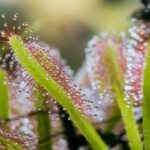As an Amazon Associate, this site earns commissions from qualifying purchases. For more details, click here.
Venus flytraps need plenty of water to survive, which is why many people leave the plant sitting in a pool of it. But is that a good idea? Too much water can cause problems so what should you do? In this guide we will look at both sides and determine which is best for your plant.
Venus flytraps benefit from sitting in water. Plant your Venus flytrap in a 3-6 inch pot and put it on a tray. Fill the tray with an inch of water and refill before the water dries up.
How to Properly Sit Venus Flytraps in Water
If you are going to do this, you must have the right materials. Fortunately the requirements are basic and easy to obtain. Once you have these it is a straightforward process.
You will need:
- 3-6 inch container with drainage holes
- Plastic tray at least two inches deep, or something like Living Whole Foods Tray
- Distilled water (reverse osmosis or rainwater are also suitable). Our choice for this would be RPI 4L Distilled Water as it is natural and free of chemicals.
- Suitable environment with light, humidity and ventilation
For sitting Venus flytraps in water, a 3-6 inch (7-15 cm) pot is the most practical. You can use a 5 inch (12.7 cm) pot as well, but some Venus flytraps get too soaked, so the deeper the pot the better. Alternatively you can use a 5 inch pot but fill the tray with only 0.5 inch (1.27 cm) of water.
When you have the materials, do the following:
Place the pot in the tray. Pour an inch of water in the tray and just let it sit there. The pot drainage holes will absorb the water and into the roots.
Refill the tray with water before it completely dries up. You have to keep the soil moist at all times. Do not let it dry.
Any plastic tray will do as long as it is large enough for the container. It should be at least two inches deep so water does not spill over.
Distilled water is the best option because it is clean and safe. Tap water has mineral deposits that will harm the plant, so distilled water is more ideal. You can also collect rainwater though that is impractical during summer.
Do not let the soil get soaked in water however. Your Venus flytrap will probably be fine, but it can make the plant vulnerable to root rot and other diseases. Carnivorous plants in general do better in moist soil, not soaked. in some cases a 4 inch pot and an inch of water is fine, but 6 inches is even better.
Reasons to Sit Venus Flytraps in Water
There are many benefits to sitting Venus flytraps in water. Assuming it is done properly as recommended above, you should see healthier traps and have less to worry about when it comes to infection. But there are other advantages to using this approach.
Avoid Overwatering
Probably the best thing about sitting the plant is you reduce the risk of overwatering. Venus flytraps, contrary to popular belief, can be overwatered.
When you water from the top, you have to judge how much or how little you pour. You have to check the soil each time to ensure it is moist but not soggy.
With the sit in water method, you don’t have to do that. An inch of water should last several hours or a whole day so you only need to check it only a few times. No need to guess if there is too much or too little water going into the plant here.
Prevents Overheating
Leaving Venus flytraps in water helps cool the environment. These plants need light, but too much heat can burn its leaves. As water seeps into the roots, it spreads throughout the leaves and improves the humidity.
Venus flytraps prefer a damp environment. This can be a problem during summer when the soil needs to be kept constantly moist. This can be an issue too particularly if your Venus flytrap is outdoors. Keep this in mind if you want to buy one and keep it inside your house.
Prevents Soil Compaction
Too much water causes the soil to squeeze in, which is not good for Venus flytraps. This usually happens when the plant is top watered as the liquid accumulates. Over time this can cause damage.
Compacted soil weakens Venus flytraps and is one of the reasons why some new growth turns black. Loose soil is required for the plant to grow healthy. Watering from the bottom reduces the possibility of this occurring.
How to Water a Venus Flytrap From the Top
As we have shown here, there are a lot of benefits in bottom watering Venus flytraps. But if you prefer top watering you can do so.
To water Venus flytraps from the top, pour water until it courses through the pot bottom. Keep doing this until the soil is moist. Repeat the process when the soil starts to dry.
This method requires careful pouring and you need to be attentive to the soil, but it does work. And most people use this method to water Venus flytraps when in dormancy.
Regardless which technique you use, the type of water used is the most important. As long as you avoid tap water then your Venus flytraps will be fine. Of course you have to use nutrient free soil so the plant can grow.
Tips For Watering Venus Flytraps Properly
Learning how to water Venus flytraps from the bottom is easy. Once you have the plant set up, keep the following guidelines in mind to get the healthiest leaves and traps possible.
Water as Often as Necessary
You do not have to stick to a specific frequency, like refill the tray with water 2 to 3 times a day for instance. It all comes down to how moist the soil is. During hot days you need to refill the tray more often. During dormancy you do not need to do this at all. Just water the plant once a month is fine.
Some Venus flytraps can handle more water than others, so check how well your plant holds up. It takes a lot to overwater Venus flytraps so your plant should be fine.
One question that often comes up is what happens if the soil is left to dry. Again you must not allow this to happen. But if it does it will not kill Venus flytraps right away. But refill the tray as soon as possible.
Use the Right Pot
For sitting in water we recommend 6 inch containers are suitable, though taller ones work for some. Glazed ceramic, Styrofoam and and plastic containers are acceptable. Do not use metallic pots.
The deeper the pot, the more water you can use. For practical purposes we suggest tall pots as it seems to be the safest.
If the pot is too shallow water might seep in too quickly and soak the soil. You can try different pot sizes later when you have grown several Venus flytraps.
Aside from the height, make sure the pot is wide enough for the plant. Venus flytrap roots expand so the pot must have enough space available.
Use the Right Soil
There are many soil mix options available, but 1:1 perlite and peat moss or 1:1 sphagnum moss and sand sand are ideal. These types are readily available and mixing is easy.
For best results, mix thoroughly with lots of water. Lukewarm or room temperature water absorbs faster than cold so try that. You can adjust the ratio for other carnivorous plants you have, but for starters 1:1 is the way to go.
It is a good idea to repot Venus flytraps each spring. Use the same soil mixture (if you liked the results) and the same pot size. Since the plant has just gotten out of dormancy, give it time to get used to the light, water and its new pot. After a few weeks the plant will settle in and you can resume the normal watering and feeding.
Conclusion
Watering is one of the most critical aspects of growing Venus flytraps. Knowing how much or how little to use can make all the difference between a healthy or dying plant. Hopefully the information in this guide was able to help you understand how the process works.

My fascination with carnivorous plants began many, many years ago with Venus Fly Traps. Now I am more than happy to impart what I know with other enthusiasts and those who are curious about meat eating plants.



